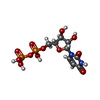+Search query
-Structure paper
| Title | Cryo-EM structure of human O-GlcNAcylation enzyme pair OGT-OGA complex. |
|---|---|
| Journal, issue, pages | Nat Commun, Vol. 14, Issue 1, Page 6952, Year 2023 |
| Publish date | Oct 31, 2023 |
 Authors Authors | Ping Lu / Yusong Liu / Maozhou He / Ting Cao / Mengquan Yang / Shutao Qi / Hongtao Yu / Haishan Gao /  |
| PubMed Abstract | O-GlcNAcylation is a conserved post-translational modification that attaches N-acetyl glucosamine (GlcNAc) to myriad cellular proteins. In response to nutritional and hormonal signals, O- ...O-GlcNAcylation is a conserved post-translational modification that attaches N-acetyl glucosamine (GlcNAc) to myriad cellular proteins. In response to nutritional and hormonal signals, O-GlcNAcylation regulates diverse cellular processes by modulating the stability, structure, and function of target proteins. Dysregulation of O-GlcNAcylation has been implicated in the pathogenesis of cancer, diabetes, and neurodegeneration. A single pair of enzymes, the O-GlcNAc transferase (OGT) and O-GlcNAcase (OGA), catalyzes the addition and removal of O-GlcNAc on over 3,000 proteins in the human proteome. However, how OGT selects its native substrates and maintains the homeostatic control of O-GlcNAcylation of so many substrates against OGA is not fully understood. Here, we present the cryo-electron microscopy (cryo-EM) structures of human OGT and the OGT-OGA complex. Our studies reveal that OGT forms a functionally important scissor-shaped dimer. Within the OGT-OGA complex structure, a long flexible OGA segment occupies the extended substrate-binding groove of OGT and positions a serine for O-GlcNAcylation, thus preventing OGT from modifying other substrates. Conversely, OGT disrupts the functional dimerization of OGA and occludes its active site, resulting in the blocking of access by other substrates. This mutual inhibition between OGT and OGA may limit the futile O-GlcNAcylation cycles and help to maintain O-GlcNAc homeostasis. |
 External links External links |  Nat Commun / Nat Commun /  PubMed:37907462 / PubMed:37907462 /  PubMed Central PubMed Central |
| Methods | EM (single particle) |
| Resolution | 3.82 - 5.86 Å |
| Structure data |  EMDB-33767: Human OGT-OGA complex (conformation I) EMDB-33768, PDB-7yea:  EMDB-33769: Human OGT-OGA complex (Conformation III) EMDB-33773, PDB-7yeh: |
| Chemicals |  ChemComp-UDP:  ChemComp-NAG: |
| Source |
|
 Keywords Keywords | TRANSFERASE / Human O-GlcNAc transferase Dimer / TRANSFERASE/HYDROLASE / O-GlcNAc transferase / O-GlcNAcase / Complex / Mutual inhibition / TRANSFERASE-HYDROLASE complex |
 Movie
Movie Controller
Controller Structure viewers
Structure viewers About Yorodumi Papers
About Yorodumi Papers







 homo sapiens (human)
homo sapiens (human)